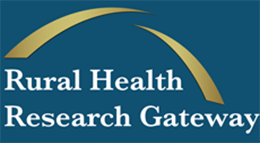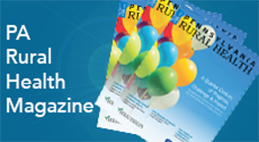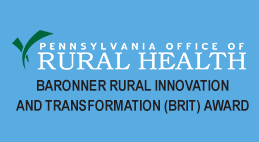- Fact Sheet: The Biden-Harris Administration Highlights Investments in Rural America, Invites Public Nominations for Rural Innovators Initiative
- Rural Victims of Intimate-Partner Violence Need More Resources and Support, Study Finds
- A Tribe in Maine Is Using Opioid Settlement Funds on a Sweat Lodge to Treat Addiction
- Fact Sheet: USDA, HHS Announce New Actions to Reduce Impact and Spread of H5N1
- Call for Experts: Forum on Aging, Disability, and Independence
- Bill to Expand Definition of 'Village' Qualifying for Water Funds Passes Alaska House
- Child Care Workers Caught in Middle of Michigan's Broken Child Care System
- Few Options Available for Substance Abuse Treatment in the Big Bend
- In Rural Texas, ERs Are Facing a Growing Mental Health Crisis
- Ways and Means Members Put Forth Solutions to Strengthen Telehealth Access and Improve Health Care for Rural Communities
- Sage Memorial Hospital in Navajo Nation Constructs New Facility to Improve Health Care
- How the State, Tribes and Federal Government Are Working to Curb SD's Syphilis Epidemic
- Rural Children Struggle to Access Hospital Services, Say Researchers
- RPHARM Program Fulfills Need for Rural Pharmacists
- A Pilot Program in Rural Vermont Hopes to Build a Blueprint for Substance Abuse Recovery
FDA Launches Vaping Prevention & Education Resource Center
The Food and Drug Administration (FDA) Center for Tobacco Products announced the launch of their new Vaping Prevention and Education Resource Center. The online resource center provides science-based, standards-mapped materials that can be used to help middle and high school students understand the dangers associated with vaping and nicotine addiction.
Affordability of Employer Coverage for Family Members of Employees
On October 11, 2022, the Internal Revenue Service released a final rule that changes the way health insurance affordability is determined for members of an employee’s family, beginning with plan year (PY) 2023 coverage. Beginning in 2023, if a consumer has an offer of employer-sponsored coverage that extends to the employee’s family members, the affordability of that offer of coverage for the family members (of the employee) will be based on the family premium amount, not the amount the employee must pay for self-only coverage.
The final rule is effective for PY2023. The change will be reflected in the online application through the HealthCare.gov enrollment platform and enhanced direct enrollment certified partner applications during the PY2023 Open Enrollment period beginning November 1, 2022. State-based Marketplaces not using the HealthCare.gov enrollment platform are also working to implement this change, but may have different implementation timelines.
To view the final rule, visit: https://www.federalregister.gov/public-inspection/2022-22184/affordability-of-employer-coverage-for-family-members-of-employees.
USDA Invests $1.8 Million to Improve Health Care in Rural Pennsylvania

U.S. Department of Agriculture (USDA) Rural Development State Director Bob Morgan today announced that USDA is awarding $1.8 million in grants to improve health care facilities in rural towns in Pennsylvania. These grants will help two health care organizations and one food bank.
“Emergency Rural Health Care Grants support rural communities in providing health care to the people and places that often lack access,” Morgan said.
The projects awarded in this round of funding are:
- The Elk Haven Nursing Home Association received a grant of $767,200 to reimburse lost healthcare revenue.
- The City of Braford in McKean County received a grant of $105,100 to purchase an ambulance.
- The Chester County Food Bank received a grant of $1 million to reimburse costs of food purchases because of the COVID-19 pandemic.
You can read the complete news release here.
New Rural Innovation Profiles Released!

The Rural Health Value team recently released two new Rural Innovation Profiles:
Experience in the Pennsylvania Rural Health Model: Barnes-Kasson County Hospital
A critical access hospital in Susquehanna, PA provides insight into their experience participating in the Pennsylvania Rural Health Model, which includes a global budget and transforming care to address community health needs.
MaineHealth ACO – Integrating and Using Data to Support Care Delivery
A predominantly rural network of hospitals and clinics in Maine integrates clinical and claims data to support improvements in care delivery and target patient needs as part of their Accountable Care Organization.
Related resources on the Rural Health Value website:
- Catalog of Value Based Initiatives for Rural Providers – One-page summaries describe rural-relevant, value-based programs currently or recently implemented by the Department of Health and Human Services (HHS), primarily by the Centers for Medicare & Medicaid Services (CMS) and its Center for Medicare & Medicaid Innovation (CMMI).
- Guide to Selecting Population Health Management Technologies for Rural Care Delivery – Better manage the health of existing patient populations by implementing technology with this guide from Rural Health Value that walks you through the process to plan for and implement the technology.
- Value-Based Care Assessment – This tool helps a rural organization assess readiness for the shift of healthcare payments from volume to value. The resulting report may be used to guide the development of action plans.
Contact information:
Clint MacKinney, MD, MS, Co-Principal Investigator, clint-mackinney@uiowa.edu
Rural Health Value helps create high performance rural health systems by building and offering an actionable knowledge base through research, practice, and collaboration. Visit www.ruralhealthvalue.org.
State Offices of Rural Health Help Rural Hospitals Face ‘Challenge’ of Extra Funding

It may sound like a good problem to have – lots of extra money for rural healthcare facilities during a medical crisis. But state Offices of Rural Health found that hospitals needed extra assistance to use the pandemic-related funds effectively.
When billions of dollars in federal funding started flowing into rural healthcare agencies as part of the American Rescue Plan, facilities turned to State Offices of Rural Health for assistance in how to use it.
Shortly after the public health emergency declaration, nearly $400 million in funding went to 1,540 rural hospitals with fewer than 50 beds through the Small Rural Hospital Improvement Program (SHIP).
Those funds were to go toward operational improvements including hardware, software and training. Additionally, the Federal Office of Rural Health Policy developed a number of programs for Medicare-Certified Rural Health Clinics (RHCs) that provided each hospital with $49,000 (in May 2020) for Covid-19 testing, another $100,000 (in June 2021) for Covid testing and mitigation, and another $50,000 (in July 2021) for Covid vaccination confidence programs.
State Offices of Rural Health helped RHCs in their own states apply for funding and track how that funding was spent. But, since each state office is different, how the state offices responded to the crises varied.
In some states, Offices of Rural Health are a function of the state government. But many are not. Tammy Norville, CEO of the National Organization of State Offices of Rural Health (NOSORH), said in an interview with the Daily Yonder that each state is different. Three state Offices of Rural Health are non-profit organizations, while 13 are located in academic settings – either universities or community colleges. The rest, she said, are part of state government. Those located in state government, Norville said, are most often located in their state’s Department of Health and Human Services, except for one which is located in the state’s Department of Agriculture.
“We like to say, when you’ve seen one state Office of Rural Health, you’re really seen one state office of rural health,” Norville said. “They’re all set up differently. Even the ones in state government offices. They’re different in how they’re staffed, how the work is distributed. It’s all depends on the state they’re in.”
At NOSORH, the goal was to provide support to state offices of rural health as they, in turn, supported their RHCs.
In some cases, that meant taking the pulse of what was going on during the pandemic and highlighting some of the best practices that were going on among the offices.
For individual state Offices of Rural Health, the funding for Rural Health Clinics came at a critical time.
Robert Duehmig, interim director of the Oregon Office of Rural Health, said in an interview with the Daily Yonder that the money was needed, but almost overwhelming.
“The amount of money that flowed from the federal government and from the state government and different entities was huge,” he said. “And it was done at a time where even if we were fully staffed, we’re not huge offices, and neither are a lot of our clinics. We were starting to close down for a period of time. The expectations of some of those funds I think were often or somewhat unrealistic.”
The Oregon Office of Rural Health’s role in distributing that money was to make sure the hospitals were eligible and to help them identify how they were going to spend those funds. Once the hospitals had signed an agreement on how they would spend those funds, the state office would distribute them.
Some eligible hospitals chose not to take the federal funds though. Five rural hospitals in Oregon did not. Duehmig said it was not that they didn’t need it or that they weren’t eligible, but that in some cases they were having trouble finding expenses to apply those funds to. In other cases, there just wasn’t enough manpower in the hospital to monitor and record how the funds were used.
In Michigan, John Barnas, executive director of Michigan Center for Rural Health, said the relationship between the center and the state health organization was key in getting grant money to the right communities.
Working with the Michigan Department of Health and Human Services, the Michigan Center for Rural Health was able to cooperatively get funding to needy rural communities. And by looking at the data, the center was able to find populations that needed the funding the most.
“We utilized population-based data to look at age demographics, race, ethnicity demographics, poverty demographics,” Barnas said. “We also looked at data around immunization levels for flu and Covid-19.”
Norville said the money came as a blessing, but also as a curse. At a time when rural health clinics were at their busiest, she said, the federal government was throwing money at them, requiring them to spend it in certain ways, and asking them to track how they spent it. That meant more labor to monitor how the money was spent, she said.
“Just think about the effort that it took to do that in the middle of a public health emergency… but these guys did it, I mean, that’s the story, right? Regardless of what left hooks came at them, they rose to the challenge. And they did what they needed to do to take care of things.”
Opioid Addiction in Farm Country a Sad Legacy
From Lancaster Farming
September was National Recovery Month, launched in 1989 to promote new evidence-based treatment, celebrate the vibrant recovery community and the service providers who furnish support, and to offer hope for those still struggling.
Three years ago in September, Pennsylvania joined Farm Town Strong, an effort spearheaded by the American Farm Bureau Federation and the National Farmers Union to bring attention to the opioid epidemic in farming communities and offer resources to those battling addiction.
The scope of the crisis in rural America was staggering, with 74% of farmers and farmworkers reporting they had been directly impacted by opioids, three in four farmers saying it was easy to access large amounts of opioids without a prescription, and one in three adults saying addiction treatment was readily available.
“Addiction is a is a complex disease that can’t be reduced down to simple neurobiology,” said Dr. Adam Scioli, medical director and head of psychiatry at Caron Treatment Center in Wernersville, Pennsylvania. The nonprofit rehab facility was founded as Chit-Chat Farms by recovering alcoholic Richard Caron and his wife, Catherine (Tildon) Caron, and opened the doors to its first patients in 1959.
Multiple factors play a role in both the development of a substance-use disorder and its progression, Scioli said, including co-occurring mental health conditions, such as depression or anxiety, that may also need addressing.
Sickness, Not Sin
“I had a mentor here many years ago who had a very, very simple way of summarizing it,” said Rev. Jack Abel, senior director of spiritual care at Caron. “He was a Catholic priest, but he used to say, ‘Jack, my understanding of this is that it’s sickness, not sin.’ And I think that can be helpful, sometimes, for people who have strong faith backgrounds.”
Faith communities especially may tend to view addiction as a moral failure, when it’s not, he said. Such a viewpoint can contribute to a reluctance to seek help, he said, and offer the false solution that a person in active addiction can simply make better choices, or simply repent
“One of the things that kind of defines addiction, in my experience, is that it’s frustratingly irrational,” Abel said, and so appealing to an addicted person’s power of reason can be useless. Thus, he said, it is difficult to intercept addictive behavior without intervention.
Faith communities excel at caring for the sick, he said, and so ministering to those afflicted boils down to changing that community’s mindset.
“It’s a different approach, where we encourage healing instead of repentance,” Abel said. “And that’s the direction that I’ve always tried to take with people, whether religious or not.”
Not Going Away
“Over the past, I’d say, 20 years, the increase in total number of deaths involving opioids, particularly fentanyl and other synthetic opioids, has increased dramatically,” Scioli said, adding that the opioid crisis was finally declared a nationwide public health emergency in the fall of 2017.
Fentanyl, which is about 100 times more potent than morphine and 50 times more potent than heroin, is sold by prescription, typically as a slow-release patch for severe pain treatment. It is also manufactured in illegal drug labs.
“We’re acutely aware here at Caron of the need to address substance use and, in particular, opioid use, because there’s a high likelihood of fatality,” Scioli said. “It certainly can happen very quickly. It certainly can happen on the very first use. And the unfortunate fact is that opioids that people are ingesting have gotten more dangerous because fentanyl has been either adulterating them, or people are actually seeking fentanyl.”
A large number of fentanyl overdoses occur in people who don’t even realize they are taking the drug, he said.
Opioids are in a class all by themselves when it comes to treating addiction, Scioli said.
“We at Caron actually have an opioid track where we focus on the disease opioid use disorder exclusively as a separate and distinct phenomenon, which requires a biopsychosocial spiritual approach,” he said.
That approach includes making sure the patient has a safe and comfortable withdrawal, helping them decide whether to use a medication — such as buprenorphine (Suboxone) — to assist recovery, and assuring they have the support network to sustain them once they leave the treatment facility.
“Addiction is certainly a family disease, and we have recognized that since our origins,” Scioli said. “There’s an expression here at Caron that resonates with me, that ‘the patient is the family and the family is the patient.’ We talked about the importance of a supportive environment, and that involves, when someone comes into treatment, making sure that their family members or loved ones understand that addiction is a disease and not a choice and that there are going to be certain supports that their loved one requires in order to succeed, not just changes at home, but attitudinal changes toward their loved one, who is now a patient.
Sadly, Scioli said, not everybody is able to overcome addiction.
“And when there’s a loss, the loss is felt by far more people than that person who was trapped in addiction probably ever realized. The disease of addiction does not discriminate based on socioeconomic status or gender or occupation—whether or not you have children or you are a child.”
National Dental Group Works to Improve Access for Patients with Disabilities
The American Dental Association (ADA) shared several ideas about how Congress can ensure greater health outcomes for people with disabilities by providing accommodations in health care settings and further developing a health care workforce that understands the needs of people with disabilities. The ADA also urged Congress to provide grants for the training and continuing education of dentists on treating patients with disabilities to dental schools, dental residency and fellowship programs, and dental associations.
Newest Data Released on Appalachian Demographics
With data from the 2016-2020 American Community Survey, the federal Appalachian Regional Commission created a chartbook with state- and county-level information on topics including age, race and ethnicity, housing occupancy, education, income and poverty, health insurance coverage, disability status, and much more.
The National Strategy to Support Family Caregivers
The Administration for Community Living provides strategies for caring for children, elderly adults, people with disabilities, people with chronic conditions, and post-acute conditions, among others. Additional resources include guidelines for the state- and community-level action, and a look ahead to more than 300 actions that federal agencies will take in the near term.
Changes in the Supply and Rural-Urban Distribution of Selected Behavioral Health Providers
This series of data briefs from the WWAMI Rural Health Research Center describes trends in the supply and distribution of selected behavioral health providers in rural and urban areas in the U.S., nationally, and within Census Divisions. The study found fewer per capita behavioral health providers in rural vs. urban counties, as well as disparities in the supply of providers across rural categories and Census Divisions. While the per capita supply of psychiatrists declined over the past decade, the supply of psychologists, psychiatric nurse practitioners, social workers, and counselors increased in both rural and urban counties.





